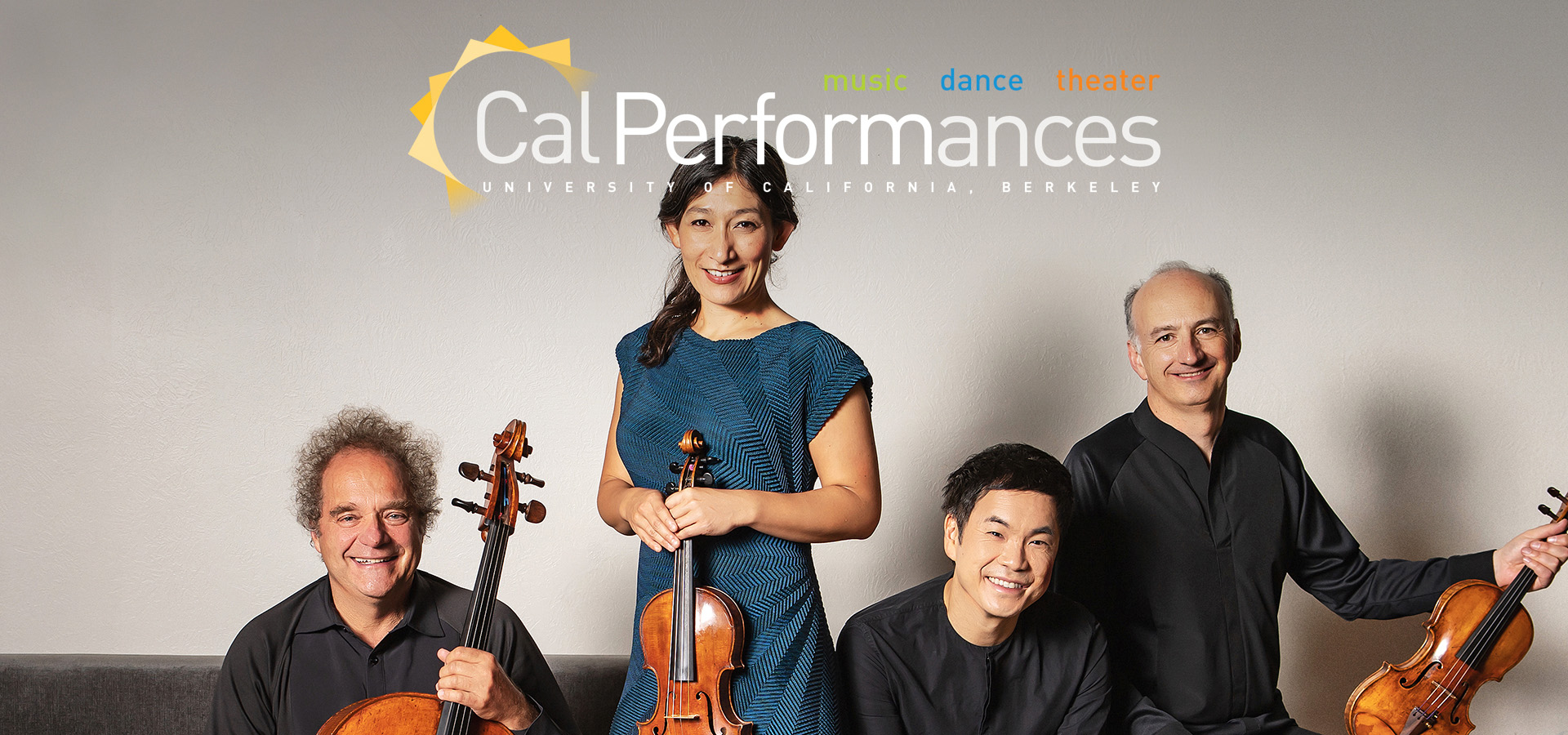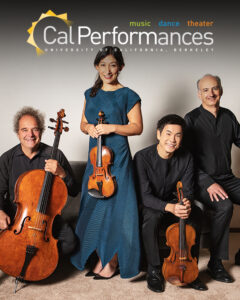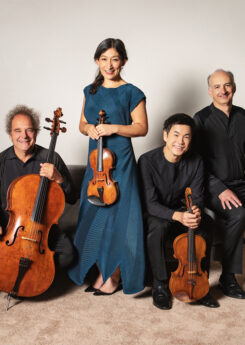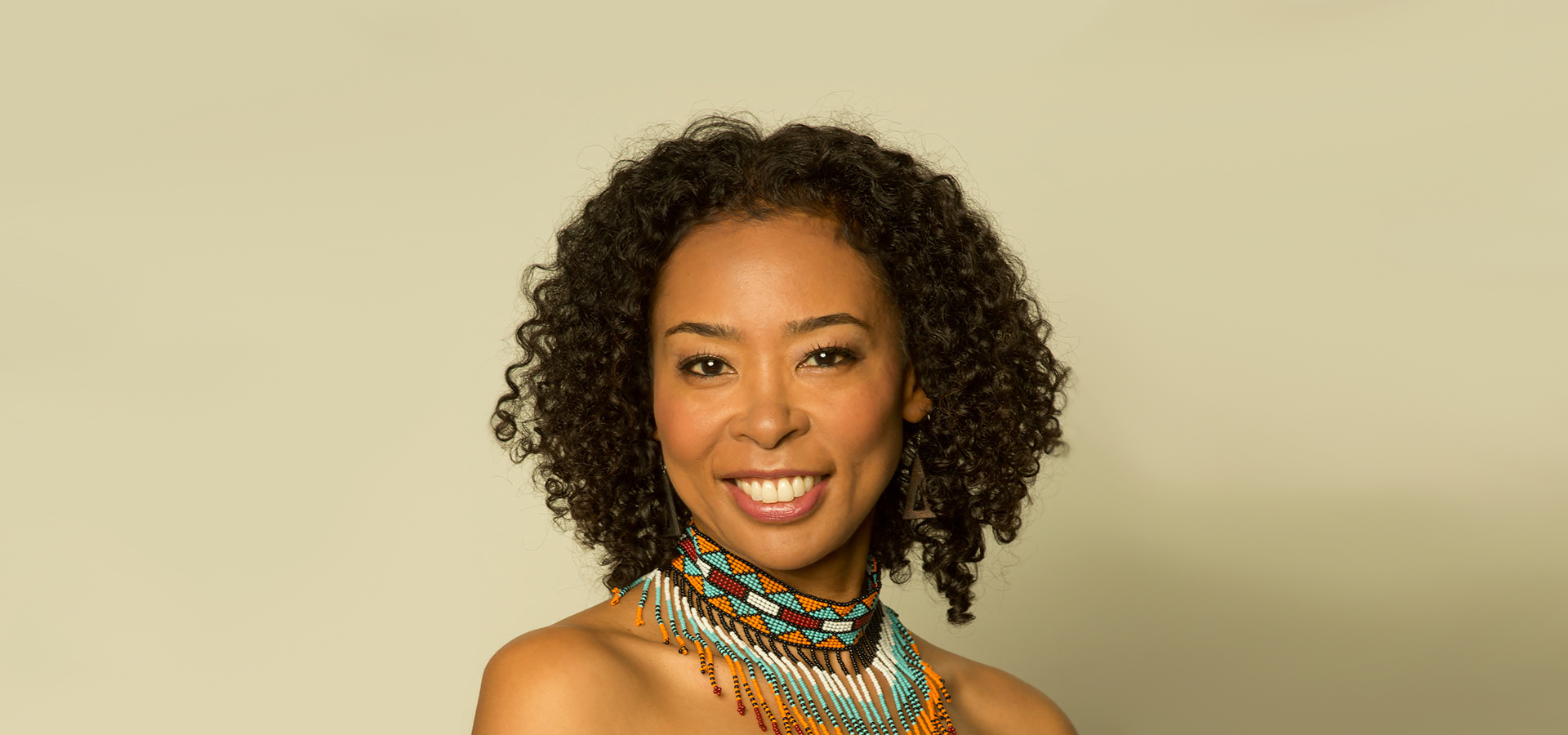The Takács Quartet
Sunday, November 12, 2023, 3pm
Hertz Hall
Edward Dusinberre, violin
Harumi Rhodes, violin
Richard O’Neill, viola
András Fejér, cello
Flow is co-commissioned by Cal Performances (Berkeley, CA), Friends of Chamber Music (Portland, OR), BroadStage (Santa Monica, CA), Shriver Hall Concert Series (Baltimore, MD), Boston Celebrity Series, 92nd Street Y (New York, NY), Philadelphia Chamber Music Society, Capital Region Classical (Schenectady, NY), and University Musical Society (Ann Arbor, Michigan).
The Takács Quartet appears by arrangement with Seldy Cramer Artists, and records for Hyperion and Decca/London Records.
The Takács Quartet is Quartet-in-Residence at the University of Colorado in Boulder; the members are Associate Artists at Wigmore Hall, London.
This performance is made possible, in part, by Françoise Stone.
From the Executive and Artistic Director
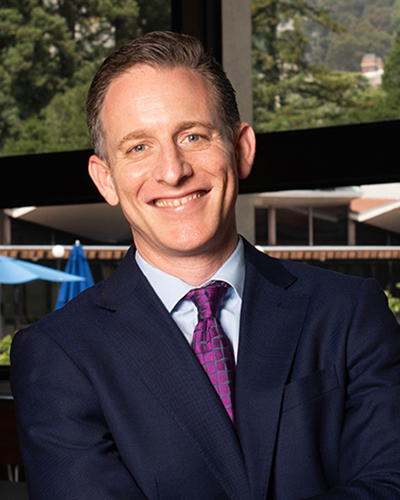
November is always a busy month at Cal Performances, and once again this season, I can’t think of a time period that so clearly displays the impressive depth and breadth of our programming. In the coming weeks alone, we’ll run the gamut of live performance, including classical-music recitals with star instrumentalists cellist Sheku Kanneh-Mason (Nov 1) and harpsichordist Jean Rondeau (Nov 5); the brilliant ensemble playing of early-music champions Le Consort (Nov 8) and the Takács Quartet (Nov 12); a return visit by the great San Francisco Symphony, performing under Music Director Esa-Pekka Salonen in a concert featuring the world premiere of a new work by Jens Ibsen and a solo turn by the orchestra’s principal clarinetist Carey Bell (Nov 10); a brilliant new program by the always popular Silkroad Ensemble under artistic director Rhiannon Giddens (Nov 17); our annual visit by The English Concert in an all-star concert performance of Handel’s Rodelina (Nov 19); cutting-edge jazz from the legendary trio of pianist Brad Mehldau (Nov 11); and highly anticipated appearances by theater/cabaret sensations John Cameron Mitchell and Amber Martin (Nov 4) and Broadway superstar Kristin Chenoweth (Nov 15).
And that’s only the start! As we continue through the season, you’ll find more than 80 carefully curated events designed to appeal to the eclectic interests and adventurous sensibilities of Bay Area audiences. In total, this year’s schedule features nearly 30 companies, ensembles, and solo artists new to our program, offering a wide range of opportunities to discover unfamiliar performers and artworks. There’s plenty to enjoy, including six world premieres, six Cal Performances co-commissions, nearly one dozen local and regional premieres, and the West Coast premieres of Taylor Mac & Matt Ray’s Bark of Millions and Nathalie Joachim’s Ki moun ou ye (Who are you?).
Cal Performances continues to invest in ongoing relationships with established and acclaimed artistic partners, with upcoming presentations including a landmark collaboration between Germany’s Pina Bausch Foundation, Senegal’s École des Sables, and the UK’s Sadler’s Wells theater in the first-ever Bay Area performances of Bausch’s pioneering The Rite of Spring (1975), as well as the renewal of a multi-season residency by The Joffrey Ballet, which this year will present its first full-length narrative ballet, Anna Karenina, at Zellerbach Hall. And I’m especially pleased that in March 2024, the renowned pianist Mitsuko Uchida will join us as Artist in Residence for two special concerts as well as additional opportunities for the campus and wider Bay Area community to engage with her singular artistry.
A focus of the season will be our multi-dimensional Illuminations programming, which once again will connect the work of world-class artists to the intellectual life and scholarship at UC Berkeley via performances and public programs investigating a pressing theme—this season, “Individual & Community.” Concepts of “individual” and “community” have been at the forefront of public discourse in recent years, with some models increasing polarization and radicalization within our society. Questions have emerged as to how we can best nurture a sense of community and how the groups we associate with impact our own sense of self. Given our fast-evolving social landscape, how can we retain and celebrate the traits that make each of us unique, while still thriving in a world that demands cooperation and collaboration? With the performing arts serving as our guide and compass, our 2023–24 “Individual & Community” programming will explore the tensions that come into play when balancing the interests of the individual with those of the group.
Please make sure to check out our website for complete information. We’re thrilled to share all the details with you, and to welcome you once again to Cal Performances!
Jeremy Geffen
Executive and Artistic Director, Cal Performances
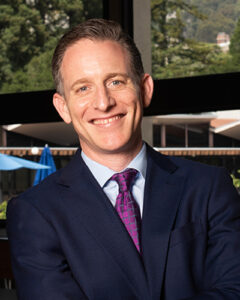 November is always a busy month at Cal Performances, and once again this season, I can’t think of a time period that so clearly displays the impressive depth and breadth of our programming. In the coming weeks alone, we’ll run the gamut of live performance, including classical-music recitals with star instrumentalists cellist Sheku Kanneh-Mason (Nov 1) and harpsichordist Jean Rondeau (Nov 5); the brilliant ensemble playing of early-music champions Le Consort (Nov 8) and the Takács Quartet (Nov 12); a return visit by the great San Francisco Symphony, performing under Music Director Esa-Pekka Salonen in a concert featuring the world premiere of a new work by Jens Ibsen and a solo turn by the orchestra’s principal clarinetist Carey Bell (Nov 10); a brilliant new program by the always popular Silkroad Ensemble under artistic director Rhiannon Giddens (Nov 17); our annual visit by The English Concert in an all-star concert performance of Handel’s Rodelina (Nov 19); cutting-edge jazz from the legendary trio of pianist Brad Mehldau (Nov 11); and highly anticipated appearances by theater/cabaret sensations John Cameron Mitchell and Amber Martin (Nov 4) and Broadway superstar Kristin Chenoweth (Nov 15).
November is always a busy month at Cal Performances, and once again this season, I can’t think of a time period that so clearly displays the impressive depth and breadth of our programming. In the coming weeks alone, we’ll run the gamut of live performance, including classical-music recitals with star instrumentalists cellist Sheku Kanneh-Mason (Nov 1) and harpsichordist Jean Rondeau (Nov 5); the brilliant ensemble playing of early-music champions Le Consort (Nov 8) and the Takács Quartet (Nov 12); a return visit by the great San Francisco Symphony, performing under Music Director Esa-Pekka Salonen in a concert featuring the world premiere of a new work by Jens Ibsen and a solo turn by the orchestra’s principal clarinetist Carey Bell (Nov 10); a brilliant new program by the always popular Silkroad Ensemble under artistic director Rhiannon Giddens (Nov 17); our annual visit by The English Concert in an all-star concert performance of Handel’s Rodelina (Nov 19); cutting-edge jazz from the legendary trio of pianist Brad Mehldau (Nov 11); and highly anticipated appearances by theater/cabaret sensations John Cameron Mitchell and Amber Martin (Nov 4) and Broadway superstar Kristin Chenoweth (Nov 15).
And that’s only the start! As we continue through the season, you’ll find more than 80 carefully curated events designed to appeal to the eclectic interests and adventurous sensibilities of Bay Area audiences. In total, this year’s schedule features nearly 30 companies, ensembles, and solo artists new to our program, offering a wide range of opportunities to discover unfamiliar performers and artworks. There’s plenty to enjoy, including six world premieres, six Cal Performances co-commissions, nearly one dozen local and regional premieres, and the West Coast premieres of Taylor Mac & Matt Ray’s Bark of Millions and Nathalie Joachim’s Ki moun ou ye (Who are you?).
Cal Performances continues to invest in ongoing relationships with established and acclaimed artistic partners, with upcoming presentations including a landmark collaboration between Germany’s Pina Bausch Foundation, Senegal’s École des Sables, and the UK’s Sadler’s Wells theater in the first-ever Bay Area performances of Bausch’s pioneering The Rite of Spring (1975), as well as the renewal of a multi-season residency by The Joffrey Ballet, which this year will present its first full-length narrative ballet, Anna Karenina, at Zellerbach Hall. And I’m especially pleased that in March 2024, the renowned pianist Mitsuko Uchida will join us as Artist in Residence for two special concerts as well as additional opportunities for the campus and wider Bay Area community to engage with her singular artistry.
A focus of the season will be our multi-dimensional Illuminations programming, which once again will connect the work of world-class artists to the intellectual life and scholarship at UC Berkeley via performances and public programs investigating a pressing theme—this season, “Individual & Community.” Concepts of “individual” and “community” have been at the forefront of public discourse in recent years, with some models increasing polarization and radicalization within our society. Questions have emerged as to how we can best nurture a sense of community and how the groups we associate with impact our own sense of self. Given our fast-evolving social landscape, how can we retain and celebrate the traits that make each of us unique, while still thriving in a world that demands cooperation and collaboration? With the performing arts serving as our guide and compass, our 2023–24 “Individual & Community” programming will explore the tensions that come into play when balancing the interests of the individual with those of the group.
Please make sure to check out our website for complete information. We’re thrilled to share all the details with you, and to welcome you once again to Cal Performances!
Jeremy Geffen
Executive and Artistic Director, Cal Performances
About the Program
Outbursts of Energy: Two Classics and a World Premiere
The string quartet, according to composer Nokuthula Endo Ngwenyama, “is considered a ‘perfect’ ensemble. It inspires delicacy, sensitivity and adventure. The core range is smaller than that of the piano, yet its timbre allows for beauteous interplay.” For the first of its two Cal Performances appearances this season, the Takács Quartet presents the world premiere of Ngwenyama’s debut in the genre, which the ensemble commissioned “because of our admiration for her as a virtuosic violist and performer who understands the dramatic and sonorous possibilities of a string quartet.”
Ngwenyama demonstrates this understanding in her new work, Flow, a centerpiece of the Takács Quartet’s current season. Responding to the ensemble’s request to write something inspired by “the natural world,” she locates her new composition in a tradition that recognizes the string quartet as uniquely well-suited to conveying profound reflections on existence and the human condition. As the composer notes, she drew on impulses from a vast array of findings in the life sciences as well as from her studies in theology and yoga practice to depict, through this intimate medium of four string players, the phenomenon of “a common flow to existence tying us to the initial outburst of energy and matter at the birth of our universe.”
The Takács Quartet aptly frames this premiere with works from the very heart of the repertoire. By evolving the string quartet across the arc of his career—and across an era of revolutionary change in philosophical concepts and political worldviews—Joseph Haydn honed the genre into a vehicle for the most sophisticated compositional craft as well as the most searching musical truths. Its lofty status is rooted in Haydn’s legacy, as exemplified by the Op. 76 quartets, which represent a pinnacle of his oeuvre and of the Western tradition alike.
Ludwig van Beethoven learned much about the subtle art of quartet writing from close study of Haydn’s example, as his first official foray into the genre with the six Op. 18 quartets shows—“the most ambitious single project of his early Vienna years,” as biographer Maynard Solomon observed. These in turn served as the springboard for his trailblazing extension of the string quartet in future works, in which Beethoven stretched its potential to unprecedented extremes of imagination and daring.
The Takács has chosen an example from the composer’s ensuing set of quartets, named for their patron Count (later Prince) Andrey Kirillovich Razumovsky, a Russian aristocrat and ambassador to Vienna. With its slow movement said to be inspired by the composer’s musing on “the music of the spheres,” the E minor Quartet of the Op. 59 set is an especially fitting choice to juxtapose with the cosmic speculations to which Ngwenyama gives voice in her contemporary take on the genre.
Sunrise and Surprise
Commissioned in the mid-1790s and dedicated to Count Joseph Georg von Erdödy, the six Op. 76 quartets are the last complete set in Haydn’s catalogue and represent the composer at the zenith of his creative power and self-confidence. He had already become an internationally acclaimed celebrity, riding a new wave of success after his two residencies in London, which resulted in the magnificent final dozen symphonies.
Haydn had since returned to Vienna and was spending the summers as Kapellmeister on the Esterházy Estate in Eisenstadt when he took up this quartet commission in 1796–1797. It represented an exception to the new creative orientation of this period, as Haydn’s focus otherwise shifted from instrumental composition toward producing sacred choral music; he would soon embark on the oratorio The Creation, the work that crowned his final decade with glory.
In Op. 76, Haydn synthesizes decades of trailblazing experience in shaping the modern string quartet. These works are replete with his trademark inventiveness and genius for upending expectations. Like Shakespeare, Haydn juxtaposes comic and tragic outlooks within a single work. Along with formal conceptualization, Haydn expands the “conversational” dimension of the genre (to allude to Goethe’s famous metaphor of the quartet as “four intelligent people conversing among themselves”).
The Quartet in B-flat major, No. 4, is one of three in the Op. 76 set to carry a nickname, the others being No. 2 (Fifths) and No. 3 (Emperor). It has become known as Sunrise (“Sonnenaufgang”) because of the preludial opening, in which the first violin serenely rises above a chordal grounding from the other strings, its melody encompassing an octave-and-a-half ascent. This metaphorical “sunrise” happens twice, before what would seem to be the actual first movement takes off. But Haydn sets all of these events within the same Allegro con spirito tempo. The idea is even reversed, with the cello moving in the opposite direction, against the ensemble harmony of the other strings. A remarkable sense of organic interconnection is sustained throughout the contrasts and detours that ensue.
The Adagio anticipates the hard-won simplicity and contemplation of late Beethoven. Even the ornamentation of this sacred secular song is more than decoration: it seems revelatory. The pathos-tinged twilight of the movement’s end is contrasted with a cheerful and downright sunny minuet. Its irresistible dance rhythm frames a peculiar outing to the countryside by way of dreamy drones—another extension of the chordal anchor that opened the piece—and unexpected pauses.
Haydn builds on a folk-like theme in the finale, subjecting it to delectable variations. The tempo accelerations in the final pages—virtuosic gear shifts—leave the listener with ever giddier pleasure.
The Flow of Existence
Nokuthula Endo Ngwenyama, who is of Zimbabwean-Japanese parentage, explains that her first and last names, respectively, signify “mother of peace” and “lion” in Zulu. A native of Los Angeles who is now based in Phoenix, Ngwenyama studied at the Colburn School, the Curtis Institute, and the Paris Conservatoire. She initially came to international attention as a violist at the age of 16, winning first prize at the fourth edition of the Primrose International Viola Competition in 1993. Her distinguished career as a violist has taken Ngwenyama to audiences around the world—including at the White House.
Parallel to her career as a soloist and chamber musician, Ngwenyama has emerged in recent years as a composer with a growing catalogue of works primarily for strings. “I write from the place that I know, which tends to come from the viola,” she says. “I think of it as the heart of the sound and feel very comfortable there.” She became the first-ever composer-in-residence with the Phoenix Chamber Music Society and is now devoting the majority of her creative time to composing—including a second piano quartet for Espressivo! with Anna Polansky, Jaime Laredo, Milena Pájaro-van de Stadt, and Sharon Robinson and a new piece commissioned for the semi-final rounds of the 2024 Primrose International Viola Competition, which will be held in June at the Colburn School in Los Angeles.
While performing at the Marlboro Music Festival, Ngwenyama got to know violinist Harumi Rhodes and welcomed the opportunity to write a piece for the Takács Quartet but also experienced a mix of emotions: “I was surprised, greatly honored, and fearful,” she recalls. The ensemble’s request that she write “about anything in the natural world”—in keeping with lead commissioner Cal Performances’ suggestion—led to more than a year’s worth of research into topics encompassing “the life cycle, carbon reclamation, environmental protection, animal communication, starling murmurations, our last universal common ancestor (LUCA), black hole collisions, and the sub-atomic realm.”
Along with Ngwenyama’s scientific investigations into such matters as cosmogony and quantum physics, Flow distills her deep study of spiritual traditions: in particular, of yoga and its understanding of the meaning of breath. (The composer also holds a master’s degree in theological studies from Harvard Divinity School.) The concepts of Om—which she defines as “the first source of sound and act of creation”—and Prana (“creative energy”) are central to Flow. Ngwenyama asks the quartet to manifest these concepts and connect with each other through breath control, which in turn is meant to encourage a mindful awareness within the audience.
“We are part of that same energy, we are the dust from these ancient creative events,” Ngwenyama observes. “And thus we are all tied together.” She describes her musical representation of Om as appearing mostly “on an upbeat as a widely vibrated pizzicato glissando in the cello imitating rhythmic placement of the gong in Balinese gamelan. That, in turn, imitates the vibrational birthing energy of our universe.” Flow relies on other extended techniques as well, such as sul ponticello overtones or astonishingly high pitches, to evoke a sense of these moments of cosmic drama.
The a priori template of a four-movement quartet was not part of Ngwenyama’s initial concept. The “Prana moment” of Flow itself—its point of origin— was instead a solo idea for the viola early in what became the finale. She continued by writing music that would culminate in this passage and was surprised to discover that the piece naturally took shape as a multi-movement form, the first three movements serving as a “preamble” leading to this original inspiration. But these in turn developed in new directions. Material from the first movement is thus developed in the finale, for example, “because all matter was put into our universe in an instant.”
Here is an excerpt from the commentary Ngwenyama has provided:
Flow starts like gas seeping from an infinitely full balloon about to pop. Then, as matter inflates space, climactic material is presented almost immediately before abruptly burning out for the universal dark ages. The Prelude examines “B’ing/BE’ing” melodically and harmonically through moments of pranayama (the transformative power of breath) [the notes “B” and “B” in tandem with “E” symbolizing hydrogen and helium, respectively]. It ends with a trailing Om.
The Lento brings further cooling and space in chorale around an octave B-centric pedal. Prelude motifs are given room to develop. The “Quark” Scherzo explores our fundamentally playful selves vibrating here, there—and where? Our sub-atomic realm giddily waltzes up and down while we embrace the ideas of solidity and ego. The opening cello mimics quark motion [i.e., triad combinations of protons and neutrons in an “up” or “down” direction]. The trio, whose only claim to three is triplets in the cello line, provides no break for anyone and instead intones a ballade. The movement ends in virtuosic flurry.
The Finale settles into a stylized recitative where three lower strings solo before coming together to feature a soaring treble voice. Flowing triplets turn into a Classical Indian Dadra Tal (even six beat) rhythm in the bass line while upper strings bow their bouts to simulate Cosmic Microwave Background (CMB) radiation. Upper strings join in via pizzicato glissandi. There is a return to the Prelude opening, then a slingshot into awe-inspiring starling murmurations. Lower strings drive unrelentingly while violin lines chase the other as one mind, instantaneously turning, merging, and transforming beyond individuality. They eventually land, the sky calms through a long D overtone glissando, and a retreating tremolo reveals: Enjoy and go with the Flow, we only know what we know.
A Return to the Quartet
When Beethoven published his first six Op. 18 string quartets in 1801, he was taking a major gamble to stake a claim within the tradition so closely associated with Haydn. He returned to the genre in 1806 in response to a commission from the Russian ambassador Count Andrey Razumovsky. But by this time, Beethoven had changed profoundly, as a man and an artist. Unlike the Op. 18 quartets, which were not published in the chronological order in which they had been composed, the three Op. 59 quartets appeared in the sequence in which they had been written when they were made public in 1808.
The first quartet of the Razumovsky set, the Quartet in F major, is often likened to the Eroica Symphony in terms of its scope and ambition, and it represents a genuine game-changer for the string quartet. Not until his late quartets (in particular, the A minor Quartet, Op. 132) did Beethoven return to such vast dimensions. The opening Allegro of the Quartet in E minor (an unusual key choice for this composer) is likewise extensive in its proportions. But it contrasts in intriguing ways with the corresponding movement in the F major Quartet. This is the only Op. 59 quartet composed in the minor mode; moreover, Beethoven here matches his economy of material—at times bordering on a kind of “anti-melody”—with a dramatic use of tense silences in a way that prefigures the Fifth Symphony (in the first stages of being sketched at the time).
The ensuing Adagio, which Beethoven asks to be “played with a great deal of feeling,” already anticipates the cosmic intimacy and spiritual inwardness of the slow movements to come in the late quartets—specifically, the epiphanic peace of the Heiliger Dankgesang—the “holy song of thanksgiving”—from the Op. 132 A minor Quartet composed in 1825. It opens with transcendently simple music in E major, hymn-like in phrasing and assurance, that spells a never-before-heard language of musical sublimity. We have no direct evidence from the composer himself as to extra-musical impulses, but Beethoven’s pupil Carl Czerny claimed that it represents his response to gazing at the starry sky above and contemplating the philosophical concept of the music of the spheres. Others might liken the rising and falling scales that recur within this rapt meditation to the angelic messengers going up and down on Jacob’s Ladder.
The nervous intensity of the Allegretto that follows comes as an almost shocking surprise in the Adagio’s wake but picks up the note of anxious unease left unresolved from the first movement. Razumovsky had requested that Beethoven include references to Russian songs in these quartets. He obliges here in the trio, set in the major, with a tune that subsequently appeared in the Coronation Scene of Mussorgsky’s Boris Godunov. (It has appealed to several other Russian composers as well.) In Beethoven’s hands, this idea gets an ironically lightweight, if not satirical, interlude.
The struggle between C major and E minor that was staged in the first movement comes to the forefront in the finale, a driven presto dance whose impulse to celebrate becomes entangled in instability. Although Beethoven seems ready to vouchsafe a “happy ending” in the accelerated coda, E minor is allowed to claim victory.
—© 2023 by Thomas May
Thomas May is a writer, critic, educator, and translator. Along with essays regularly commissioned by the San Francisco Symphony, the Juilliard School, the Ojai Festival, and other leading institutions, he contributes to the New York Times and Musical America and blogs about the arts at www.memeteria.com.


